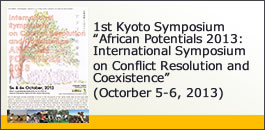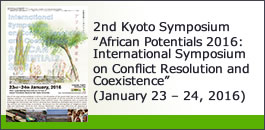[2nd Seminar on Conflict and Coexistence in Africa] (October 20, 2012)
Date: October 20, 2012. 13:30 – 18:00
Venue: Inamori Foundation Memorial Bldg, Small-sized Meeting Room, Kyoto University
Program
13:30 – 14:35: Hideyuki Okano (Osaka University)
Role of the State and Maintenance of Local Social Orders in Republic of Sierra Leone
14:35 – 14:45: Break
14:45 – 15:50: Shinichi Fujii (Osaka University)
Anthropology of/and Conflict Resolution: Cases of ‘Ethnic Violence’ in Solomon Islands
15:50 – 16:00: Break
16:00 – 17:05: Miki Ito (Osaka University)
Ethnic Groups and their Subsistence Activities in Niger Inner Delta
17:05 – 18:00: General Discussions
Summary
Role of the State and Maintenance of Local Social Orders in Republic of Sierra Leone
Hideyuki Okano (Osaka University)
Nothing can be free from state systems today, and not excepting how local social orders are maintained. This presentation discusses how the state intervened in the process of exhaustion and break–up of social orders in rural villages in Sierra Leone, and what kind of parts the state took in the process of their recovery.
Anthropology of/and Conflict Resolution: Cases of ‘Ethnic Violence’ in Solomon Islands
Shinichi Fujii (Osaka University)
This presentation first reviews how anthropological studies dealt with conflict resolution. Then, resolution process of ‘ethnic conflict’ in Solomon Islands is investigated. Finally, this presentation explores the possibility of/and conflict resolution, reviewing reconstruction process of social orders in Solomon Islands.
Ethnic Groups and their Subsistence Activities in Niger Inner Delta
Miki Ito (Osaka University)
This presentation focuses on the multiple ethnic groups in Niger Inner Delta, especially the relationships between pastoral Fulbe and its agricultural neighbors. It explores how they shared natural resources, how they resolved conflicts, and how their relationships have changed during these 30 years, responding repeated droughts and changes in market relations.
[6th Meeting of Culture and Society Research Unit / 7th Public Workshop] (Co- organized by the 7th Kyoto University African Studies Seminar (KUASS),October 9, 2012)
Date: Tue., Oct. 09, 2012 15:00-17:30
Venue: Inamori Memorial Foundation, Kyoto University
Chiefdom in Africa: An institution of the past or for the future?
Petr Skalník (University of Hradec Kralove, Czech Republic)
Abstract
Chiefdoms have been in many ways transformed during the colonial and post-colonial times but they still exist in many parts of Africa, Oceania, the Americas and even in Asia. In Europe and non-native America various institutions such as political parties, trade unions, sports clubs and corporations function in ways that resemble chiefdoms. Chieftaincy in Africa is partly discredited and partly revered as a moral authority. In Ghana people and ethnic groups, especially those labeled “acephalous” vie for attaining chiefly status. “Chieftaincy quarrels” lead to armed clashes, unrest and loss of identity. At the same time the modern state in Africa is mostly corrupt, structurally weak or violent towards its own citizens. Chiefs still enjoy high moral status or strive to regain it. At the moment one witnesses revival of chiefdoms’ role as central institution of African society. The solution to the dilemmatic situation might be to “tame” the imported state by according to the chiefs the role of watchdog of democracy. I call it the New Indirect Rule, based on equality of state and chiefdom principles. Is it a wishful thinking or a viable project? What can we learn from Africa?
[7th Public Workshop / 6th Meeting of Culture and Society Research Unit] "Chiefdom in Africa: An institution of the past or for the future?"Petr Skalník (University of Hradec Kralove, Czech Republic) (Co- organized by the 7th Kyoto University African Studies Seminar (KUASS), October 9, 2012)
Date: Tue., Oct. 09, 2012 15:00-17:30
Venue: Inamori Memorial Foundation, Kyoto University
Chiefdom in Africa: An institution of the past or for the future?
Petr Skalník (University of Hradec Kralove, Czech Republic)
Abstract
Chiefdoms have been in many ways transformed during the colonial and post-colonial times but they still exist in many parts of Africa, Oceania, the Americas and even in Asia. In Europe and non-native America various institutions such as political parties, trade unions, sports clubs and corporations function in ways that resemble chiefdoms. Chieftaincy in Africa is partly discredited and partly revered as a moral authority. In Ghana people and ethnic groups, especially those labeled “acephalous” vie for attaining chiefly status. “Chieftaincy quarrels” lead to armed clashes, unrest and loss of identity. At the same time the modern state in Africa is mostly corrupt, structurally weak or violent towards its own citizens. Chiefs still enjoy high moral status or strive to regain it. At the moment one witnesses revival of chiefdoms’ role as central institution of African society. The solution to the dilemmatic situation might be to “tame” the imported state by according to the chiefs the role of watchdog of democracy. I call it the New Indirect Rule, based on equality of state and chiefdom principles. Is it a wishful thinking or a viable project? What can we learn from Africa?
[First Seminar on Conflict and Coexistence in Africa] (July 30, 2012)
Date: July 14, 2012. 11:15-14:45
Venue: Inamori Foundation Memorial Bldg, Small-sized Meeting Room, Kyoto University
Program
11:15-11:45: Tetsuya Ohno (Toin Yokohama University)
Conflicting Forms of Legitimacy: The Protest against the Kakamega Forest National Reserve in Kenya
11:45-12:15: Hidyeuki Okano (JSPS/ Osaka University)
How Armed Conflicts Expand to Neighbors: Alliances of Armed Factions beyond the Border between Liberia and Sierra Leone
12:15-12:45 Tea Break
12:45-13:15: Futoshi Kato (Japan Society for the Promotion of Science)
Avoidance of Land-use Conflicts and Development of a Cooperative Relationship between Farmers and Agro-pastoralists in a Floodplain: A Case Study of the Kilombero Valley, Tanzania
13:15-13:45: Mihoko Nakazawa (Kobe University)
Living Environments of Orphans and their Impact on Education in Tanzania
13:45-14:15: Sota Harako (Kyoto University)
Integrating and Separating Settlements and Sharing Forest Resources in Shifting Cultivation: A Case Study of a Mountain Village in Southeastern Tanzania.
14:15-14:45: Meyu Yamamoto (Kyoto University)
Reconstruction of Racial Categories in Post-Apartheid South Africa: Chinese Communities in South Africa during the Past Century
Summary
Conflicting Forms of Legitimacy: The Protest against the Kakamega Forest National Reserve in Kenya
Tetsuya Ohno (Toin Yokohama University)
Many regions in the contemporary world are struggling to revitalise local communities. In this context, some communities with unique cultural or natural resources have been pursuing this goal by registering as National Reserves. Indeed, many governments are seeking to register with the National Reserve to turn their unique cultural and natural resources into tourist attractions.
However, the National Reserve has another important purpose: “Development through protection.” This differs substantially from the policy of “either protection or development”, which has been maintained by many governments. The role of National Reserve sites as tourist attractions makes it possible to pursue development without destroying significant cultural or natural resources.
Although the Kakamega Forest in the western province of Kenya has been registered as a National Reserve site, some people still strongly oppose this status. Why are they objecting?
Taking this question as a starting point, this presentation introduces the logic behind their objections while exploring another possibility for community revitalisation based on arguments drawn from the field of anthropology.
How Armed Conflicts Expand to Neighbors: Alliances of Armed Factions beyond the Border between Liberia and Sierra Leone
Hidyeuki Okano (JSPS/ Osaka University)
Since the initiation of the first Liberian civil war (1989), both Liberia and its neighbouring countries (Sierra Leone and Cote d’Ivoire) have experienced armed conflicts. At present (as of June 2012), armed groups remain active in the border areas between Liberia and Cote d’Ivoire, and are both cause and effect of the continued insecurity associated with the expansion of armed conflict into neighbouring countries. Indeed, even though one conflict may end, others continue. I have collected life histories of combatants and commanders in Liberia and Sierra Leone to clarify how armed conflicts expand to neighbouring countries.
During the conflict in Sierra Leone (1991–2002), local leaders created community-level vigilantes. One vigilante group, the Kamajors, was established by the Mende people. However, the Kamajors were mobilised by the regime of Ahmed Tejan Kabbah (1996–1997/1998–2007) as a pro-governmental force. When the Kabbah regime was overthrown by a coup, the Kamajors started to fight against the junta (Armed Forces Revolutionary Council, AFRC). This presentation examines themovement of Kamajors from the overthrow of the Kabbah regime (May, 1997) to his reinstatement (March, 1998).
During this period, the behaviour of Kamajors epitomised the cross-border influence of armed conflicts. Indeed, they received reinforcement from stations at the Sierra Leone–Liberia border, and key persons associated with both Liberia and Sierra Leone have used their human networks to help the Kamajors. By examining the Kamajor movement and its use of transnational human networks consisting of several key persons, I clarify how one conflict can be influenced by a conflict in an adjacent country.
Avoidance of Land-use Conflicts and Development of a Cooperative Relationship between Farmers and Agro-pastoralists in a Floodplain: A Case Study of the Kilombero Valley, Tanzania
Futoshi Kato (Japan Society for the Promotion of Science)
Paddy fields and grazing lands are increasing in swamps in Sub-Saharan Africa as a result of land development. The Kilombero Valley, an inland flood plain located in the southern part of Tanzania, covers an area of about 11,600 km2. Land development was promoted in this valley, and it became a major rice production area, accounting for about 10% of all the rice produced in Tanzania. Furthermore, the Kilombero Valley became a major cattle production area after the migration of the Sukuma agro-pastoralists to the valley.
Land competition in this area caused conflict between agriculturalists and agro-pastoralists, which led to riots. However, the relationship between agriculturalists and agro-pastoralists became cooperative in the context of a system of mutual help, which was implemented in the agricultural sector as a result of mediation performed by elders in the community. As part of the reconciliation process, agro-pastoralists used oxen to plow the paddy fields of the agriculturalists, while agriculturalists allowed the agro-pastoralists’ cattle to graze in the village. The council of elders encouraged this process. In the Kilombero Valley, cultural values (e.g., respect for elders), technology (e.g., ox-plowing techniques), and resources (e.g., animal power and foraging) contributed to reconciliation between agriculturalists and agro-pastoralists.
Living Environments of Orphans and their Impact on Education in Tanzania
Mihoko Nakazawa (Graduate School of International Cooperation Studies, Kobe University)
The HIV/AIDS pandemic has caused a rapid increase in the number of orphans and other types of vulnerable children in Tanzania. It has been reported that 10% of children in mainland Tanzania are orphans who have lost at least one parent (TACAIDS, 2008). In many cases, orphans are socioeconomically more vulnerable and disadvantaged than are children with both parents, especially in terms of educational opportunities.
Nevertheless, it is also believed that family networks have mitigated the detrimental impacts of orphanhood. Child fostering had been widely practiced among relatives in Tanzania even before HIV/AIDS pandemic. Previous studies have cited such family networks as the reason for the slight difference between the rates of primary school enrollment among orphans and non-orphans.
In this study, based on field research conducted from December 2011 to March 2012, we explored the potential of Tanzanian society to advance opportunities for coexistence by clarifying the mechanisms underpinning the social inclusion of orphans and elucidating how this affects their education.
Integrating and Separating Settlements and Sharing Forest Resources in Shifting Cultivation: A Case Study of a Mountain Village in Southeastern Tanzania.
Sota Harako (Kyoto University)
Implementation of the policy of villagisation in Tanzania during the 1970s led to the incorporation of small scattered villages into Ujamaa village. Although the Tanzanian government had created a civil infrastructure and social services in the village, these institutions were beset by financial difficulties soon after they were established. In 1986, the government implemented economic deregulation, promoted decentralisation, and enacted policies designed to reduce poverty after 2000.
In Ifinga Village, located in the southeastern part of the Eastern Arc Mountains, scattered settlements engaged in shifting cultivation were integrated into a single village consisting of various clans and tribes. Their lifestyle changed from one in which they moved their field and house every 2 years to one in which they remained in Ujamaa Village to cultivate the land. In 1972, before villagisation, the bamboo growing wild near Ujamaa Village flowered prodigiously, and the seeds of these plants were broadcast. Cultivation of these seeds produced the vast bamboo forest near Ujamaa Village. Due to the difficulty of clearing fields in bamboo forests, most farmers left the bamboo forest and moved to a forest consisting of trees. Starting in 2000, reliance on a market economy became widespread in this village as a result of road maintenance. Famers built their houses in Ujamaa Village to ensure access to social services and the market economy while also cultivating the tree forest, which became more peripheral, and narrower, due to the expansion of the bamboo forest. Settlements constructed in fields in which shifting cultivation was performed consisted of individuals who had to move every time they shifted fields. This practice facilitated the sharing of land resources and eased tensions among people.
Reconstruction of Racial Categories in Post-Apartheid South Africa: Chinese Communities in South Africa during the Past Century
Meyu Yamamoto (Kyoto University)
Despite their small numbers, Chinese residents is indispensable to an exploring and understanding of South African racial policies. Indeed, the first industrial colour barriers were erected specifically to exclude Chinese individuals from skilled occupations. Today, racial conflict about the historical treatment of Chinese individuals under the apartheid government persists. This presentation underscores the contribution of studying the treatment of Chinese residents to an understanding of racism and racial policies in South Africa during the past century. It will address the following topics: 1) the history of the treatment of Chinese residents since the late 19th century, and 2) the 2008 ruling by the Pretoria high court that the Chinese community be included in the definition of “black people” for purposes of economic empowerment.
[5th Plenary Committee Meeting] “A Summary of Activities in FY 2011 and Further Proposals for the Fiscal Year 2012” (March 29, 2012)
Date: March 29, 2012
Venue: Inamori Foundation Memorial Bldg. (Inamori Center), Middle-sized Meeting Room (Room No. 332), Kyoto University
Program
10:00-10:30 Business Meeting
10:30-12:30 Motoji Matsuda (Kyoto University) / Eisei Kurimoto (Osaka University)
Report of“The 1st International Forum: Conflict Resolution and Coexistence through Reassessment and Utilization of “African Potentials”” in Nairobi and Summary of the Discussion
13:10-14:10:
Shinichi Takeuchi (JICA Research Institute)
Report on the Activity of Research Unit on Politics and International Relations
Motoki Takahashi (Kobe University)
Report on the Activity of Research Unit on Economy and Development
Gen Yamakoshi (Kyoto University)
Report on the Activity of Research Unit on Livelihood and Environment
Motoji Matsuda (Kyoto University)
Report on the Activity of Research Unit on Culture and Society
14:10-14:30
Itaru Ohta (Kyoto University)
Further Proposals for the Fiscal Year 2012
Report Overview
1. Motoji Matsuda and Eisei Kurimoto reported on the proceedings and results of the Forum on African Conflicts and Coexistence, held 2-4 Dec. 2011 in Nairobi, Kenya:
First and foremost, this forum was significant in that it confirmed the idea that, “Conflicts are to be resolved through the utilization of the African potentials.” This idea was unanimously recognized and reestablished as the starting point to all conflict resolution among the participating African researchers and activists.
Second, the forum devoted much discussion on how to tackle the difficulties inhibiting the practical application of the African potentials. The African participants evaluated the forum highly, as it elucidated the major issues on conflict and coexistence. The feedback to the organizers was that the issues brought to fore in this forum should be revisited in the ensuing forums of the following fiscal years, as well as that some core participants should be reinvited to the forums and remain in the overall project to ensure meaningful continuity in the research.
2. Each [organizer /overseer /facilitator] of the 4 units (the Politics and International Relations Unit, the Economy and Development Unit, the Livelihood and Environment Unit, and the Culture and Society Unit) announced their progress report. (Shinichi Takeuchi substituted for Mitsugi Endo who was unable to attend.) The Project Leader, Itaru Ota, made further proposals for the fiscal year 2012 to each unit on the major issues to be emphasized. (Reporter: Toru Sagawa.)
[4th Plenary Committee Meeting] “Land, Resource, and Conflict in Africa” (January 28, 2012)
Date: January 28, 2012
Venue: Inamori Foundation Memorial Bldg. (Inamori Center), Middle-sized Meeting Room (Room No. 332), Kyoto University
Program
10:15-11:15 Motoki Takahashi/ Hiroki Ohta (Kobe University)
Politics of Property Right: Land Problems, Development and Conflict in Africa
11:15-12:15 Jun Ikeno (Kyoto University)
Policy Changes, Urban Development, and Local Public Goods: Incendiary Factors Concerning “Commons” in Northern Tanzania’s Mwanga Region
12:45-13:45 Shuichi Oyama (Kyoto University)
Conflict Over Land between Farmers and Pastoralists in the Sahel: Rebuilding of Coexistence Relationship Utilizing Local Potential
13:45-14:30
Discussion
Report Overview
Three presentations (one was a joint presentation) were conducted during the 4th general meeting on the current issue of conflict and coexistence over land in various regions across the African continent.
Motoki Takahashi/ Hiroki Ohta (Kobe University)
Politics of Property Right: Land Problems, Development and Conflict in Africa
Africa’s economy is continuing to grow since the beginning of the 21st century, but it is currently in a transitional period. The first presenter, Motoki Takahashi (joint presentation with Hiroki Ohta) stated that the important point to clarify is the direction of this transition. Population increase must be a major focus because the African population is expected to increase 2.5 times from 2010 to 2060. This indicates a societal shift from land abundance to land scarcity in Africa. Resource scarcity has caused a discrepancy where existing policies are unable to cope, and policy adjustments are required to address the exposed differences. The current implementation of individual land possession rights in Kenya, where Takahashi has conducted field research, has led to the exclusion of certain groups and thus caused a scarcity of land for these groups. This may lead to political opposition and conflicts. The construction and implementation of land policy is often also connected to the politicians’ greed. Takahashi stated that it is important to incorporate the indigenous knowledge of coexistence in the creation of African policies, particularly in the new property rights maintenance policy that is presently being developed.
Jun Ikeno (Kyoto University)
Policy Changes, Urban Development, and Local Public Goods: Incendiary Factors Concerning “Commons” in Northern Tanzania’s Mwanga Region
Jun Ikeno, the second presenter, offered several provocative issues and points of conflict related to “local commons” in the Mwanga region of Tanzania, which require adjustments and mediation. For example, the town of Mwanga is experiencing the removal of trees and gravel from the riverbed owing to a heightened demand for construction materials related to economic development and a subsequent increase in new construction. Degradation of the environment is becoming a problem because this land has no clear ownership. The public water utility has installed water meters in surrounding villages because water facilities were needed to accommodate the population increase. However, villagers living near Mwanga town had created and maintained their own water facilities prior to town development and have refused payment to the utility company. In addition, sales of land around the town have increased, and an influx of new residents to this land has led to new problems. Ikeno has stated that although these problems have not yet led to armed conflicts, it is important to consider the roles of various actors in the conflict by defining the incendiary factors prevalent in the local society. He closed the presentation by adding that instead of presuming the local population to always be “right,” researchers must consider whether the proposed changes will cause problems in the future.
Shuichi Oyama (Kyoto University)
Conflict Over Land between Farmers and Pastoralists in the Sahel: Rebuilding of Coexistence Relationship Utilizing Local Potential
Shuichi Oyama, the third presenter, explained the background and current situation surrounding conflicts between pastoralists and farmers of the Sahel region of Niger. In the past, farmers (primarily the Hausa) and pastoralists (primarily the Fulbe) created a mutual economic exchange system of bartering agricultural and pastoral products. However, grazing land was turned into Hausa farmland and the land for pastoralists was reduced considerably. As a result, livestock cause heavy damage to agricultural products, particularly during the rainy season, which is also harvest time. Although negotiations continue on monetary settlements for crop damage, contradictions sometimes appear between the statements made by farmers and pastoralists regarding the actual damage. These contradictions lead to conflicts, even to the point of homicide when agreements are not reached. Furthermore, a gap exists between the wealthy and the poor in the farmer population, and the poor farmers vent their frustration on the wealthy in the form of violence against the pastoralists. On the other hand, some initiatives are underway to foster new coexistence relationships and alleviate conflicts. In the case of a crop being damaged, a designated pastoralist would mediate, thus avoiding further deterioration of relationships. Oyama is personally attempting to implement the alleviation of conflict using the traditional expertise of the Hausa. Specifically, one area is promoting afforestation by using city waste. This restored green land is then utilized for raising livestock thus creating a space that can be used in “kowa” (unity). (Reporter: Toru Sagawa)
[3rd Plenary Committee Meeting] “Activities of Truth and Reconciliation Commission (TRC) and Reconciliation among Peoples in South Africa” (November 26, 2011)
Date: November 26, 2011
Venue: Gakuyu Kaikan, Meeting Room, Kyoto University
Program
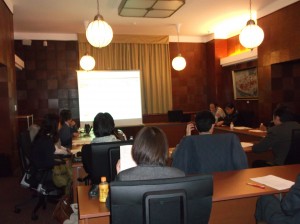
10:15-11:15 Toshihiro Abe (Otani University)
South Africa’s Truth and Reconciliation Commission (TRC) and Its Aftermath
11:15-12:15 Yoichi Mine (Doshisha University)
The Mystery of Justice and Spheres of Intimacy—A Record of the South African TRC by a ‘Conscientious Afrikaner’
12:40-13:20 Meyu Yamamoto (Kyoto University)
Reconciliation and Amnesty in the TRC
13:20-14:30
Discussion
Report Overview
Toshihiro Abe (Otani University)
South Africa’s Truth and Reconciliation Commission (TRC) and Its Aftermath
Toshihiro Abe presented an assessment and analysis of the South African TRC’s activities and characteristics. The Commission’s activities had a legal foundation in the 1995 TRC Law. However, they lacked any legal definitions of “truth” and “reconciliation.” To assure the legitimacy of its activities, the commission was careful to conduct investigations in public hearings and keep records. Grants of amnesty were one of the Commission’s frequently highlighted activities. However, these grants were not rooted in such a spirit as “post-apartheid mutual forgiveness.” Two prerequisites existed for a grant of amnesty: the offense in question was “political violence” and the testimony brought forth was “full and complete testimony.” Furthermore, the actual amnesty hearings were notably different from normal judicial proceedings, and the interaction between the commission members and those gathered at the hearings sometimes led to instances in which offenders changed their previous attitude of denying and started apologizing. These cases were publicized to a wide audience by the mass media, such as TV.
Abe noted that a 2011 survey of public opinion highlighted negative responses to the question of whether the TRC served to improve race and ethnic-group relations. Criticism was also leveled inside and outside South Africa, claiming, for example, that the “TRC did not sufficiently call out the apartheid government officials,” “TRC should have the authority to investigate corruption during apartheid,” and “fundamental direction and principles of the TRC are biased.” While emphasizing the variety of viewpoints on how to assess and situate the TRC, Abe argued that rather than functioning to resolve and “eliminate enmity between racial groups,” the TRC was likely a medium for “transitioning from armed conflict to (non-violent) negotiation, transaction, and competition” in South African society. (Reporter: Toru Sagawa)
Yoichi Mine (Doshisha University)
The Mystery of Justice and Spheres of Intimacy—A Record of the South African TRC by a ‘Conscientious Afrikaner’
Having penned a commentary in the Japanese translation of the book Country of My Skull (Gendai Kikakushitsu, 2010), Mine’s discussed the TRC-inspired book and its author. The strong international focus on the TRC was caused by the following characteristic features of the TRC among other things: Its scale and detailed testimonial records, its introduction of a full-fledged amnesty system, the manner of examining the historical relationship between Africa and the West in regard to assigning blame for racism. Moreover, the TRC with such characteristics was set in South African history of suffering much wanton death. The book was written by a South African journalist who issued reports directly from the TRC proceedings. The book does not simply present the relations between victims and perpetrators during apartheid as blacks against whites but maintains the complexity of the relationships as they really were, as in the cases of whites who were killed while participating in the liberation movement, and blacks who became police spies.
The author, Antjie Krog, is an Afrikaner—a descendant of the first white (mostly Dutch) immigrants who settled in what is now South Africa in the mid-17th century. During the apartheid era, whites were able to live normal lives in South Africa, with the majority basically oblivious to the large-scale, institutional discrimination and human rights violations that were taking place against blacks. As a journalist in charge of reporting the outrageous violence that came to light through the TRC, Krog had to constantly face the fact of her complicity as one of the oppressors and reflect on it as she carried out her work. Krog also writes critically about how the TRC became politicized by the National Party, the ANC, and others. At the same time, having covered the entire process of the TRC, Krog brings her book to a close by looking forward to the possibility of the creation of a community of new South Africans who uphold the honor of their affiliated group while also acknowledging their sins and responsibilities, or in other words, a “fusion of dignity and redemption of a higher dimension.” (Reporter: Toru Sagawa)
Meyu Yamamoto (Kyoto University)
Reconciliation and Amnesty in the TRC
In the context of a review of the amnesty approval process of the Truth and Reconciliation Commission (TRC), Yamamoto clarified the difficult circumstances surrounding the authorizing of “justice” and people’s opposition to revisiting the past violence. The Amnesty Committee served to approve amnesty for actions, inactions, and violations under apartheid and in connection with political ends during 1960–1994. The approval for amnesty was conditional upon an individual’s confession of past transgressions. The total number of amnesty petitions submitted was 7,115, and 1,167 of them were approved. The majority of the petitions came from individuals already imprisoned, and the number submitted by apartheid government officials and military leaders was small. Former administration officials criticized the amnesty grants owing to the uniform reprieve given to ANC members. On the other hand, the criticism offered by ANC intellectuals concerned whether or not violence committed as an act of resistance should be pardoned. Yamamoto also explained the various views on the pros and cons of distinguishing between anti- and pro-apartheid strife, how Mandela’s speeches lent efficacy to the TRC, and how the ANC intelligence agency filed for amnesty, thus quieting the internal voices of criticism. Moreover, Yamamoto spoke about whether it is possible ethically to distinguish violence under apartheid and whether violence in the form of resistance is a crime. She then summarized the issues surrounding the TRC, noting the difficulty of authorizing “justice” in modern conflicts. (Reporter: Shuichi Oyama)
Discussion
During the discussion time, first, two perspectives emerged on the issue related to the systems and the workings that concluded the TRC. One view was that the TRC activities were certainly a significant opportunity to transform the manner in which South African history and society were approached; however, it was inappropriate to see those activities as an end point to conflict resolution and reconciliation. The TRC recognized “multiple truths” in addition to “legal truth,” allowing testimony and official records of various opinions and interpretations regarding apartheid that would have been impermissible under normal law. However, many voices existed that were not heard during the TRC proceedings and attempts were made afterward to hear such voices outside the proceedings.
Another perspective was that the issue of the effectiveness of conflict resolution in South Africa should not be reduced to an explanation of the institutional problems of the TRC. The reason for this is that conflict resolution is determined by the manner in which the conflict started and developed, whether it ended, and what entities assumed political power afterward. The possibility for transitional justice is entirely dependent upon the path that the society in question took up to that point. Thus, when considering the “leveraging” of African Potentials, it is possible that the degree to which any leveraging can occur in conflict resolution rests on reflection, in each individual case, on the state of the conflict that arose and the systems that followed in the particular country or region.
Concerning African Potentials, it was mentioned that Abe’s point, that “The TRC was more likely a medium for ‘transitioning from armed conflict to (non-violent) negotiation, transaction, and competition’ in South African society,” might also very well apply in this case. “Negotiation, transaction, and competition,” for example, are similar to the ritual processes observed across Africa. That is, the “unification of communities by implementing ritual” presumed by functionalistic analysis actually very rarely proceeds in a unidirectional fashion, and the ritual often fails. However, this failure does not mean that the people see the ritual as fundamentally flawed. Rather, by continually repeating the ritual and re-negotiating each time, a “provisional truth” is worked out that allows the participants to address the state of affairs. It was argued that such negotiation leaves open an avenue for handling situations and can sow seeds of hope.
Meanwhile, even if the TRC was more likely a medium for “transitioning from armed conflict to (non-violent) negotiation, transaction, and competition,” the following questions were raised: Was the TRC indeed became a forum for facing the concerns of those who lost their lives while participating in the anti-apartheid conflict? Did the TRC rebuild South Africa in a manner that would lead to restoring a type of balance that could bring security to the lives of surviving relatives? Which parties were able to participate in the TRC as equal players, and which were not? What level of power had to be wielded to secure a place as an equal player in the first place? In addition, it was noted that two and a half years was an unreasonably short span of time for the TRC to judge historical prejudice that had been ongoing since the middle of the 17th century. It would not be surprising, then, if the commission continued till this day.
Finally, overlapping with the discussion from the 2nd research meeting on the post-election violence in Kenya’s last election, when considering options for Africa’s conflict resolution overall, participants exchanged opinions in which they envisioned a division of labor of sorts that would enlist “legal judgment” via domestic courts, the ICC, etc. for treating large-scale human rights violations such as apartheid, while leveraging African Potentials for conflicts that arise in a more local context. (Reporter: Toru Sagawa)
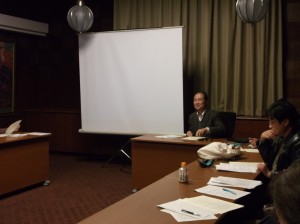
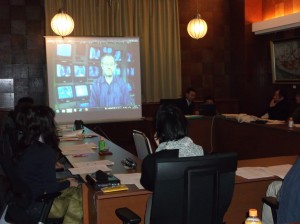
[2nd Plenary Committee Meeting] “Post-Election Violence (PEV) in 2007-2008 and its Reconciliation Process in Kenya” (September 23, 2011)
Date: September 23, 2011
Venue: Inamori Foundation Memorial Bldg. (Inamori Center), Middle-sized Meeting Room (Room No. 332), Kyoto University
Program
11:00-12:00 Miwa Tsuda (Institute of Developing Economies)
From Mediation to International Criminal Court: Coping with PEV in Kenya
12:00-12:30 Motoji Matsuda (Kyoto University)
Tasks and Problems of the Truth, Justice and Reconciliation Commission in Kenya
12:30-13:00 Naoki Naito (National Museum of Ethnology)
Confrontation of Local Groups Caused by General Election and its Local Solutions: A Case of the Pastoral Ariaal in Northern Kenya
13:00-14:30
Discussion
Report Overview
Three speakers presented talks that focused on the Post-Election Violence (PEV) in Kenya from 2007 to 2008 and the subsequent conflict-resolution processes.
Miwa Tsuda (Institute of Developing Economies)
From Mediation to International Criminal Court: Coping with PEV in Kenya
Miwa Tsuda first addressed the damage caused by the hostilities and the circumstances that led to the eruption of PEV. She then spoke about the setbacks in the post-conflict reconciliation process in Kenya that ended with the involvement of the International Criminal Court (ICC). The Waki Commission’s October 2008 report had advised for a special tribunal for the PEV within the nation; however, a lack of majority support in the parliament resulted in failure to establish the tribunal. A year later, in October 2009, President Kibaki and Prime Minister Odinga announced their intentions to entrust the ICC with the prosecution of the PEV perpetrators named by the Waki Commission. In December 2010, the ICC opened two cases of “crimes against humanity” during the PEV, naming six individuals implicated in the cases. In March 2011, summonses were issued for these people. Currently, the first phase of judicial proceedings is being held in the Pre-Trial Chamber of the ICC, and it is being debated whether sufficient evidence exists for each criminal charge against the accused. During the inquiry, it has been argued that Kenyan support for the ICC comes mainly from the urban intellectual class, while the majority of Kenyans see the six subpoenaed individuals as “martyrs, sacrificed to Western European colonial power.”
Motoji Matsuda (Kyoto University)
Tasks and Problems of the Truth, Justice and Reconciliation Commission in Kenya
The following speaker, Motoji Matsuda, explained the process for establishing the Truth, Justice and Reconciliation Commission (TJRC) in Kenya, and current developments surrounding it. The commission was ratified in April 2008 and began its activities in August 2009 on the basis of the principles of “national healing and reconciliation.” However, the commission was not active. In April 2011, local hearings finally began in various regions of the country. The commission is exploring how to use the model of South Africa’s post-apartheid Truth and Reconciliation Commission’s dialogue-based reparative justice. Criticism of the commission, however, focuses on the possibility that the dialogues will be used as political tools to delay the punishment for the perpetrators named in the Waki Report. Furthermore, it has been pointed out that there is no political legitimacy for a truth commission to be established by the current president’s administration, which has held sway at the center of Kenya’s politics since independence. It has been also noted that the period of history at issue only begins from national independence in 1963, ignoring discussion of the grave human-rights violations that occurred prior to the period when Kenya was under the control of the British colonial government. During the question-and-answer session, participants discussed the average Kenyan citizen’s views about and expectations from the commission and how these expectations were strikingly low. It was also mentioned that newspaper articles on the subject are rare. Moreover, when such articles do appear, news of the ICC is printed on the political news pages, while that of the commission is relegated to general or miscellaneous columns. The question was raised as to why, in the case of not only Kenya but also other countries, Western nations frequently have high expectations for initiatives such as truth commissions, whereas the citizens of the country in question do not particularly pay much attention to them.
Naoki Naito (National Museum of Ethnology)
Confrontation of Local Groups Caused by General Election and its Local Solutions: A Case of the Pastoral Ariaal in Northern Kenya
The third presenter was Naoki Naito, who spoke about the Ariaal people of northern Kenya and how deeply hostile relations developed between them and their neighbors on the occasion of the national parliamentary elections. Naito also discussed the extent to which these hostilities receded after the elections. In 2003, the Constituency Development Fund was introduced in Kenya, allowing members of parliament to freely use part of funding distributed to their electoral districts. As a result, local interest in elections rose. Over an electoral zone, a candidate from the Ariaal society labeled the Rendille people (who up to that time had been known as kinsmen by the Ariaal) as enemies. This deepened divisions between the social groups. However, after the elections, rather than speaking about the differences that were created and intensified during the elections, people chose to conceal them in order to prevent any further deterioration of relations. Naito emphasized that this stance of “muting” themselves functioned to avoid any exacerbation of the enmity. During the question-and-answer session, the issue came up of whether irreversible changes had occurred between the daily life before the elections and the restored daily life after the heightened animosity between the social groups.
Discussion
Initially, during the overall group discussion, the talk centered on how to relate the ICC stance of calling for “punishment through impartial laws” and the “African approach” to conflict resolution when dealing with PEV in Kenya.
First, it was noted that there is domestic criticism within Kenya of the practice of “punishment through impartial laws” that was attempted by the ICC. However, the criticism is partly driven by politicians who seek the continuation of the political impunity they enjoy. The speakers noted that there is considerable danger of them being seen as aligning with such a viewpoint in the lack of careful management of their anthropological argument, which is that “rather than imposing Western norms of universal justice, avenues should be explored to address the current state of affairs by leveraging African Potentials.”
Furthermore, the participants voiced their thoughts on the debate over the assertion by international society that “the ICC should pass judgment according to the global standards of law because if matters are left to Africa, punishment will only be avoided.” The discussion brought up a host of points: (1) Matters must proceed on the basis of the fundamental principle that judgment in some form must be passed on those who transgressed. (2) The Kenyan government should take some blame for the involvement of the ICC because it was they who failed to establish the special tribunal. (3) There is a strong possibility that neglecting punishment will re-manifest a long-term trend of “skirting the blame.” However if outside agencies participate in passing judgment and punishment, then the long-term impact should also be considered, such as a backlash of nationalism in the country concerned. (4) The international law is heading toward a direction where it should not expound the form of universal justice that simply overlooks a regional context but rather continue to consider the framework of public opinion in each country that it judges. (5) Even for the ICC—the steward of “impartial law”— while decision making is being carried out by recourse to laws, extralegal factors warrant real consideration as well in the process of judging the perpetrators.
In addition, assertions were made that the people of Africa do not overreact to the mediation by the ICC and this is a typical “African” response. Further, while handling the perpetrators, all participants—the ICC, state, and local communities—rely upon basic standards that are established by the international society, mainly of the West. However, a majority of African societies generally have a more diluted approach to disciplining “criminals.” As such, the discussion noted that it may be necessary to shift the boundary between “grave violations” and problematic behaviors.
Discussion then focused (not solely in the case of Kenya but other African nations as well) on whether more general “African Potentials” can be effective in reconciling and controlling large-scale organizational violence during and after conflict. It was pointed out that, first of all, because “African Potentials” have been downplayed till now, it is necessary to start considering them as a means to address and suppress conflict. At the same time, however, there certainly are limitations to the capacity of these potentials, and therefore it is necessary to study the problems they can and cannot resolve. In connection with this issue, it was mentioned that there exist “points of no return” in tremendously escalated violence (such as in Rwanda’s 1959 social revolution hostilities) that make it extremely difficult to suppress conflicts emerging from very large-scale organized unrest. Conversely, it was also noted that before reaching such points, “African Potentials” should be leveraged so that the possibility of turning back still exists in the background. Last, it was stated that despite the continued prevalence of violence in various African societies, it is important to clarify and illuminate the characteristics of those societies that have been relatively successful at stemming conflict at an early stage. (Reporter: Toru Sagawa)
[1st Plenary Committee / 1st Public Lecture] “Conflict Resolution and Coexistence in Africa”(July 2, 2011)
Date: July 2, 2011
Venue: Inamori Foundation Memorial Hall (Inamori Center), Kyoto University
Contents
The greatest obstacles facing modern African society are the impoverishment and disintegration of the social order caused by conflict. In particular, since the 1990s, large-scale civil wars and regional strife have erupted regularly, and multifarious conflicts have been occurring, such as violent clashes over land ownership and use, as well as territorial disputes over political resources. The international society has been seeking a solution to this state of affairs according to the normative values and concepts that originated in the U.S. and Europe, such as liberal democracy.
In response to these issues, our workshop takes an entirely different stance, namely, that the knowledge and institutions created, developed, and employed by African people can also serve to achieve conflict resolution and a state of coexistence. However, such knowledge and institutions are not fixed and unchanging entities within Africa. Rather, they have grown out of Africa’s repeated interaction, both consonant and dissonant, with the outside world. This workshop will strive to consider avenues for leveraging Africa’s knowledge and institutions in order to resolve current disputes and recover a cohesive social structure.
Keywords
Peace-building, Nation-building, Post-conflict, Rwanda, South Sudan
Program
3:30-13:45 Itaru Ohta (Kyoto Unversity)
Introduction
13:45-14:45 Eisei Kurimoto (Osaka University)
Unrestored Peace at the Community Level: Challenges and Limits of Peace-Building in “Post-War” Southern Sudan
14:45-15:00 Break
15:00-16:00 Shinichi Takeuchi (JICA Research Institute)
Rwanda’s Gacaca under Post-Genocide State-Building
Report Overview
Itaru Ohta (Kyoto Unversity)
Introduction
This workshop is a 5-year research project, officially titled “A Comprehensive Regional Study on Conflict Resolution and Coexistence through Leveraging Africa’s Potentials,” which started in academic year 2011 (also the foundational year of the JSPS’s Grants-in-Aid for Scientific Research [S]). Ohta, the representative of the project, explained outline of the project. Modern African society is confronting the formidable obstacles of impoverishment and disintegration of the social order caused by conflict. Ohta argued that in the face of these real-life challenges, instead of importing Western systems and values to the African continent, this project seeks to clarify new avenues for effectively utilizing the knowledge and institutions created, accumulated, and employed by African people (“African Potentials”) such that they can be used to contribute to conflict resolution and social order construction (co-existence). (Reporter: Itaru Ohta)
Eisei Kurimoto (Osaka University)
Unrestored Peace at the Community Level: Challenges and Limits of Peace-Building in “Post-War” Southern Sudan
The second speaker, Kurimoto, talked about the peace-building in “post-war” southern Sudan. Ever since the signing of the 2005 Sudanese Comprehensive Peace Agreement, the government forces and the Sudan People’s Liberation Army (SPLA) have been maintaining peace in southern Sudan (which is scheduled to become independent in July 2011). However, peace at the community level has not been accomplished, and armed conflicts are erupting not only between different communities but also within communities. Although peace discussions are held in certain areas to promote reconciliation at the community level, the results have not been substantive. Furthermore, other regional areas exist where no such initiative has been taken at all. In order to rebuild the society, it is essential to follow “peace from below” approaches that focus on endogenous, community-level peace initiatives, and also organically join these movements with “peace from above” that is implemented by government agencies.
During the question-and-answer session, discussion was generated from questions that included, “What specifically needs to be done to support ‘peace from below’ activities?”; “Who will conjoin the ‘peace from below’ and ‘peace from above’ movements, and how will they do that?”; and “Isn’t it necessary to stimulate business activity on a more individual level rather than just holding peace conferences?” (Reporter: Toru Sagawa)
Shinichi Takeuchi (JICA Research Institute)
Rwanda’s Gacaca under Post-Genocide State-Building
The third speaker, Takeuchi, talked about Rwanda’s post-conflict state-building. On the basis of the World Bank’s governance indexes of “political stability” and “voice and accountability,” three types of post-conflict state-building were distinguished: (1) where both indexes were stagnant (e.g., Afghanistan, Sudan), (2) where the “political stability” index considerably exceeded the “voice and accountability” index (e.g., Rwanda, Angola), and (3) where both indexes showed parallel improvement (e.g., Sierra Leone, Burundi). Regarding the post-conflict state-building, the international community has emphasized the necessity of enhancing not only the state capacity of providing basic social services including security, but also state legitimacy vis-à-vis the society. Among the above-mentioned three types, the first two clearly indicate a gap between the goals promoted by the international community and actual status of state-building. While the type (1) shows the lack of state capacity for the provision of security, the type (2) demonstrates a risk of the authoritarian state-building, which may damage the state legitimacy. In fact, a propensity toward authoritarianism among countries that have experienced serious internal conflict has been so far observed. Examining the experiences of post-conflict state-building in Rwanda, Takeuchi indicated its achievements and challenges. On the one hand, the country has succeeded in maintaining social order under the rule of the Rwandan Patriotic Front, the former rebel led by ethnic minority. On the other hand, the priority of political stability may have hampered the enhancement of liberal democratic governance. Inclusiveness in the governance as well as economic development should be consciously taken into account in its state-building process
During the question-and-answer session, debate centered on the differences in the post-conflict societies in Rwanda and Burundi, the manner in which the conflicts ended, and the great relevance of the degree of involvement of the international society. (Reporter: Shuichi Oyama)
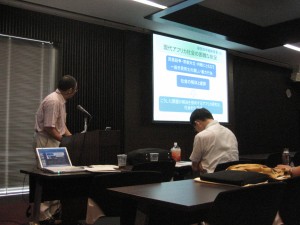
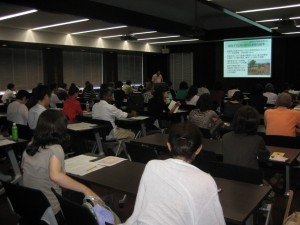
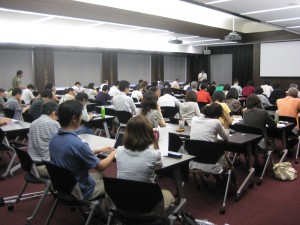
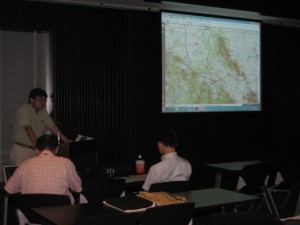
[4th Culture and Society Unit Meeting] (2012.01.28)
Date: Sat., Jan. 29, 2012 15:00-18:30
Venue: Inamori Memorial Foundation, Kyoto University
Program
15:00~16:00
Misa Hirano (Tenri University)
“The Development Process and Conflicts among Bamileke Chiefdoms in Cameroun”
16:10~17:10
Rumi Umino (Meiji Gakuin University)
“Create History, Connect with Others”: The Techniques to Avoid Conflicts among the Griqua in South Africa”
17:20~18:30
Discussion
Report
Misa Hirano (Tenri University)
“The Development Process and Conflicts among Bamileke Chiefdoms in Cameroun”
Bamileke is a group of people living in the west area of Cameroun and has formed more than 100 chiefdoms. These chiefs were frequently fighting each other before the colonization. In this presentation, by using the oral tradition, it was analyzed how the chiefdoms had been formed. It is possible that some small chiefdoms were already formed in the 16th century. It is conceivable that small groups who moved in during the 17th to 18th century formed new chiefdoms by conquering the local people, and the centralization was furthered through the accumulation of wealth by slave trade, etc. The current system was completed when the German settled in at the end of 19th century.
Inside each chiefdom of Bamileke, frictions and internal disputes between the chiefs and the local residents, the resolution and the coexistence were repeated. And among the chiefdoms, the wars broke out because they insulted each other, which resulted in the territorial expansion of the dominant societies and the formation of identity of each chiefdom. However, there also existed systems to resolve or avoid such conflicts through trading, exchanging captivities and forming marital relations.
Rumi Umino (Meiji Gakuin University)
“Create History, Connect with Others”: The Techniques to Avoid Conflicts among the Griqua in South Africa”
The purpose of this presentation is, by studying the people of Griqua living in Republic of South Africa, to indicate that the practice of what they called “history” itself and the rules manifested through the practice (or something what should be called the premise of conducts) consequently lead to the avoidance of conflict with the others. Griqua people are mainly the descendants of Khoikhoi, with those of the San, European immigrants, Bantu and the released or escaped slaves, who formed themselves by calling themselves “Bastards” by the late 18th century, which includes many communities consisting of the chief and the supporters.
From the middle of 1990’s, they started to be connected to the indigenous people’s working group of United Nations and defined themselves as indigenous. Also, they found out that the other Khoisan from Southern Africa participated in this working group and deepened the exchange and partnership with them. Analyzing that process indicates that there existed three what could be called behavioral principals (= rules), which were deeply related among each other; “accept others”, “rearrange flexibly” and “maintain autonomy”. It seems that those rules and conducts consequently helped them avoiding conflict with others and led to maintain coexisting relationships. (Itaru Ohta)
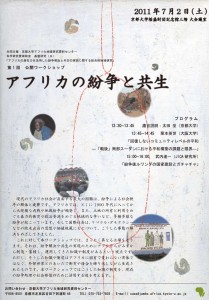
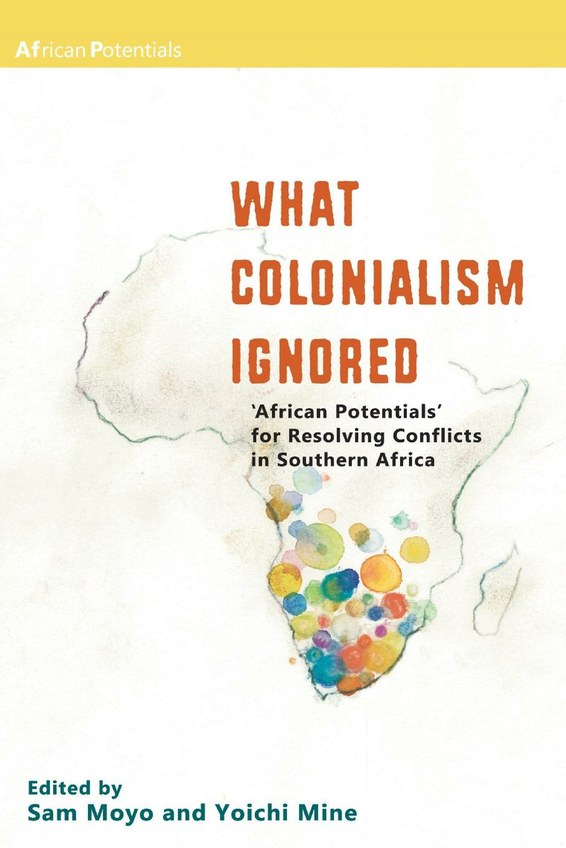
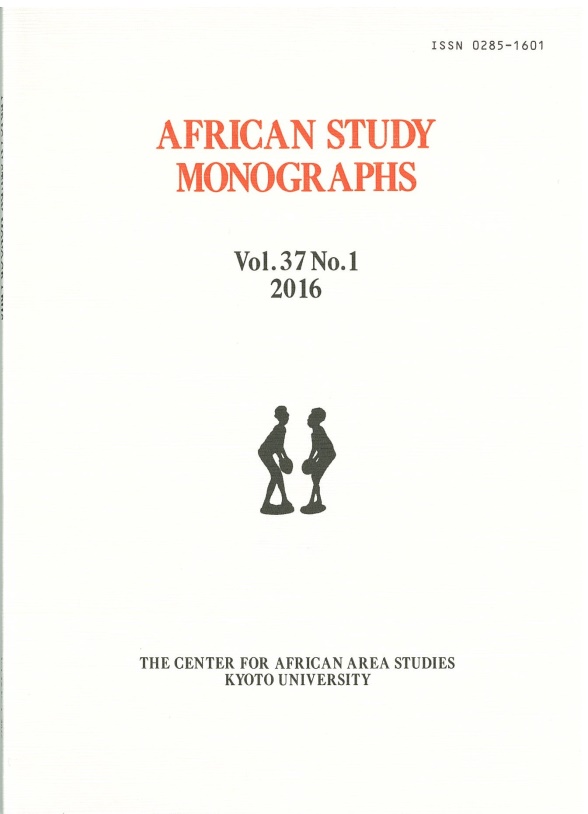
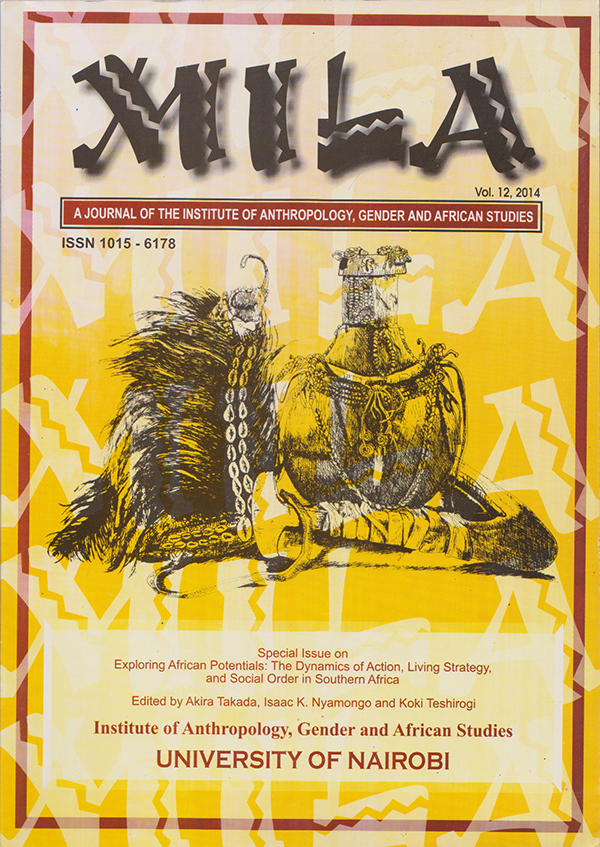 Exploring African Potentials, Mila Special Issue
Exploring African Potentials, Mila Special Issue